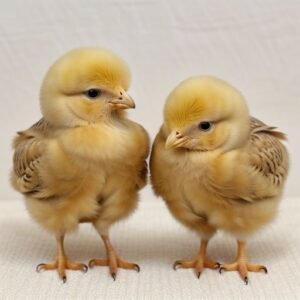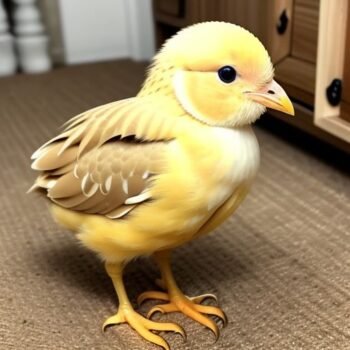Discover everything about Jubilee Orpington chicks, from history and characteristics to the right chicks, and caring for them, and expert tips on feeding, shelter, health maintenance, the beginning of an egg-citing journey, and financial benefits.
Meet the Jubilee Orpington Chicks
Jubilee Orpington chicks are truly a joy to have in any poultry lover’s collection. Their captivating appearance and friendly nature make them instant favorites among those who get to know them. However, there’s more to these adorable chicks than just their charm. It’s important to have a good understanding of their needs to ensure they thrive and stay healthy.
Jubilee Orpington Chicks Origin and History
Before we jump into the specifics of caring for Jubilee Orpington chicks, let’s first understand their background and what sets them apart. These charming birds have a rich history dating back to the early 20th century when they were initially bred in England by William Cook. Originally, Jubilee Orpingtons were carefully bred as dual-purpose birds.
Jubilee Orpington Chicks Appearance
When Jubilee Orpington chicks hatch, they emerge with an irresistible fuzziness that adds to their charm. Their downy feathers are not only soft to the touch but also showcase a vibrant color pattern that catches the eye.
Jubilee Orpington Chicks Colors
Jubilee Orpington chicks feature shades of buff, gold, and black in their downy feathers.
Jubilee Orpington Chicks Size and Weight
Jubilee Orpington chicks typically grow to be robust, with an average size of 7 to 8 pounds for hens and 10 to 12 pounds for roosters.

Selecting the Right Jubilee Orpington Chicks
Whether you’re a seasoned poultry enthusiast or just starting out, the key lies in picking healthy chicks that will thrive under your care.
Choosing Healthy Chicks
When it comes to selecting Jubilee Orpington chicks, keep an eye out for certain characteristics that indicate good health and vitality. Look for chicks that are alert, active, and lively, with bright eyes and clean feathers. Avoid chicks that seem lethargic, have ruffled or dirty feathers, or show any signs of illness.
Finding a Reputable Breeder
Seek out breeders known for their commitment to genetic diversity, proper nutrition, and ethical breeding practices. Building a relationship with a trustworthy breeder not only guarantees access to healthy chicks but also provides invaluable support and guidance.
Assessing Chicks for Health and Vitality
Before making your final decision, take the time to thoroughly assess each potential chick to ensure it meets your standards for health and vitality. Observe the chick’s appearance, behavior, and overall demeanor, paying close attention to any signs of illness or distress. Inquire about the chick’s vaccination history and any health guarantees offered by the breeder.
10 egg-laying chickens for beginners.
Preparing Jubilee Orpington chicks Home
To ensure the well-being of Jubilee Orpington chicks, it’s crucial to create a cozy and secure environment right from the start.
Setting Up the Brooder
The brooder is where your chicks will spend their early days, so it needs to be just right. Make sure it’s spacious enough, ideally measuring at least 2 square feet per chick. Place the brooder in a draft-free area away from direct sunlight and other pets.
Temperature and Humidity Control
Maintain temperatures between 90 to 95°F in the first week, gradually decreasing each week until reaching room temperature. Keep humidity levels consistent, ideally around 50 to 60%, by using a hygrometer to monitor levels.
Brooder Size and Setup
Give your chicks plenty of room to move around and explore by providing a spacious environment. Designate areas for feeding, resting, and grooming to keep them comfortable and content.
Essential Supplies
Equip your brooder with feeders, waterers, bedding materials, and heat sources. Make sure they have access to specialized chick feed to support their growth.
Feeders and Waterers
Place feeders and waterers in easily accessible locations within the brooder. Ensure they are stable and secure to prevent spills and contamination. Keep them clean and replenished regularly to promote healthy eating and drinking habits.
Bedding Material
Choose absorbent bedding like pine shavings or shredded paper to keep the brooder clean and cozy. Avoid materials such as cedar shavings or sawdust, as they can irritate chicks’ respiratory systems. Spread a layer of bedding at least 1 to 2 inches thick throughout the brooder, ensuring it remains dry and comfortable for the chicks.

Caring for Jubilee Orpington Chicks
Taking care of Jubilee Orpington chicks involves paying close attention to their temperature (already discussed above), feeding, and hygiene needs to ensure they grow up healthy and happy.
Feeding:
Offer chick-specific feed formulated for their nutritional needs, such as starter or chick crumbles. Ensure access to fresh water at all times.
Hygiene Practices:
Clean the brooder regularly, replacing bedding materials every 1-2 weeks, and sanitize feeders and waterers every week to prevent bacterial growth. Wash hands before and after handling chicks.
Preventing Diseases:
Implement biosecurity measures, quarantine new birds, and limit exposure to wild birds and pests. Monitor chicks for signs of illness and seek veterinary care promptly if needed.
Growth and Shelter
Milestones and Coop Design:
As Jubilee Orpington chicks grow, their housing needs evolve too. It’s essential to design a coop that can adapt to their changing requirements.
Growth Stages of Jubilee Orpington Chicks:
From adorable hatchlings to fully-grown adults, Jubilee Orpingtons undergo significant growth. Your coop should cater to their needs at every stage, offering enough space and amenities to support their development.
Designing a Comfortable Coop:
Imagine your coop as a cozy retreat for your chickens. It should be spacious, well-ventilated, and insulated, providing a safe haven regardless of the weather. Consider adding perches, nesting boxes, and roosting areas to keep your birds content.
Outdoor Space Needs:
Just like us, Jubilee Orpingtons love some fresh air and sunshine. Make sure your coop includes outdoor runs where they can stretch their wings, peck at the ground, and bask in the sunlight. A happy chicken is one that gets plenty of outdoor time.
Providing Ample Outdoor Area:
Think of the outdoor space as their playground. Aim for at least 10 square feet per chicken to give them enough room to roam and explore. Add features like dust baths and hanging treats to keep them entertained and engaged.
Protection from Predators: (common predators and ways to protect are discussed in coming lines.
Unfortunately, predators are always on the lookout for a chicken dinner. Keep your flock safe by installing sturdy fencing, predator-proof locks, and reinforced coop walls. Regularly inspect your defenses to ensure they’re up to the task of keeping unwanted visitors out.

Techniques for Handling and Socialization:
When handling Jubilee Orpington chicks, it’s crucial to be gentle and patient. Use slow, deliberate movements to avoid startling them, and support their bodies securely to prevent injury. Talk to them in soothing tones to help them feel at ease in your presence.
Encouraging Interaction:
Building a bond with your Jubilee Orpington chicks starts with positive interaction. Spend time sitting near their brooder, offering treats from your hand, and speaking softly to them.
Socializing Chicks with Humans:
Early socialization is key to raising friendly and sociable Jubilee Orpingtons. Handle them regularly from a young age, gently stroking their feathers and speaking to them softly.
Introducing Chicks to Other Chickens:
When the time comes to introduce your Jubilee Orpington chicks to the rest of your flock, do so gradually and under supervision. Start by placing the chicks in a separate area within the coop, allowing them to see and hear the older chickens without direct contact. As they grow bigger and more confident, you can gradually integrate them into the main flock, ensuring a smooth transition for everyone involved.
Raising White Leghorn Chicks: From Fluff to Feathers
Protecting from Predators
Identifying Common Predators:
- Common Predators: Raccoons, foxes, hawks, snakes, and stray dogs are common threats to Jubilee Orpington chicks.
Ways to Prevent Predator Attacks:
- Fortify the Coop: Ensure your coop is secure with sturdy fencing and locks. Use hardware cloth or wire mesh to prevent digging or climbing.
- Deterrents for Protection: Install motion-activated lights or sound devices to startle nocturnal predators. Consider reflective objects or noise-making devices near the coop to deter daytime threats.
- Keep it Clean: Maintain cleanliness around the coop area. Dispose of food scraps promptly and regularly remove hiding spots like tall grass or bushes.
- Supervise Outdoor Time: Monitor chicks closely during outdoor sessions. Provide shelter and hiding spots for safety and rotate grazing areas to avoid overexposure to predators.
- Stay Vigilant: Regularly check the coop for signs of attempted entry or disturbance. Address any vulnerabilities promptly to keep your chicks safe.
Egg-citing Journey Begins:
After approximately six to eight months, Jubilee Orpington hens will reach maturity and start laying eggs regularly. This marks the beginning of your egg-citing journey into breeding.
Timing and Collection of Eggs:
- Consistent Collection Schedule: Establish a regular routine for collecting eggs to ensure they are gathered promptly after being laid, minimizing the risk of breakage or contamination.
- Frequency: Check nesting boxes at least once or twice daily, preferably in the morning and evening, to retrieve eggs while they’re still fresh.
- Storage: Store collected eggs in a cool, dry place away from direct sunlight, ideally in an egg carton with the pointed end facing downward to help maintain freshness.
Selecting Breeding Stock:
- Health and Vitality: Choose breeding stock from healthy, robust Jubilee Orpingtons that exhibit desirable traits such as good egg production, strong eggshell quality, and overall vigor.
- Genetic Diversity: Opt for breeding pairs with diverse genetic backgrounds to maintain genetic diversity within your flock and minimize the risk of inbreeding.
- Temperament: Select birds with a docile and friendly temperament, as these traits can be passed down to future generations, making them easier to handle and manage.
Financial Benefits with Jubilee Orpington Chicks and Chickens
With Chicks:
- Selling Chicks: Earn extra income by selling mature Jubilee Orpington chicks to fellow enthusiasts or farmers.
- Hatching Eggs: Offer fertile hatching eggs to customers interested in raising their own Jubilee Orpington chicks.
- Egg Production: Profit from consistent egg-laying by selling fresh Jubilee Orpington eggs locally or at markets.
- Meat Sales: Capitalize on flavorful Jubilee Orpington meat by selling dressed birds to markets or restaurants.
Conclusion:
In conclusion, embarking on the journey of raising Jubilee Orpington chicks encompasses not only the joys of nurturing adorable fuzzballs into majestic birds but also the practical aspects of providing a comfortable home, nutritious feed, and protection from predators. From setting up the brooder to selecting the right feed and implementing predator prevention measures, we’ve covered it all. As you embark on this fulfilling adventure, remember that each step contributes to the well-being and success of your flock. With dedication and care, your Jubilee Orpingtons will thrive, rewarding you with not only financial benefits but also the satisfaction of a job well done. Here’s to creating a happy and thriving environment for your feathered friends!

